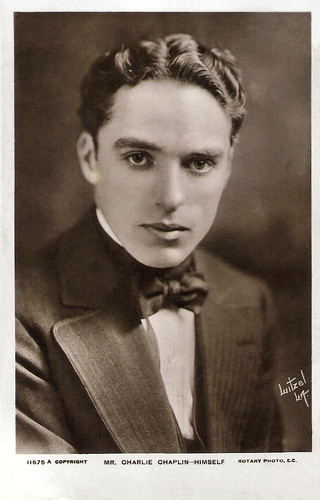
British postcard by Rotary, no 11675 A. Photo: Witzel.
In 1914, English comedian Charles ‘Charlie’ Chaplin (1889-1977) invented his classic character the Tramp! With his toothbrush moustache, undersized bowler hat and bamboo cane, the tramp struggled to survive while keeping his dignity in a world with great social injustice. Chaplin was one of the most creative and influential personalities of the silent film era. He used mime, slapstick and other visual comedy routines, and he not only starred in his films, but also directed, wrote and produced them, and composed the music as well.

Austrian postcard by Iris Verlag, Wien, no. 404. Photo: Witzel L.A. / Fox Film.
Blond Florence Gilbert (1904-1991) was an American silent film actress of the 1920s. She was renowned for playing supporting roles alongside such actors as William Fairbanks and Jack Hoxie.
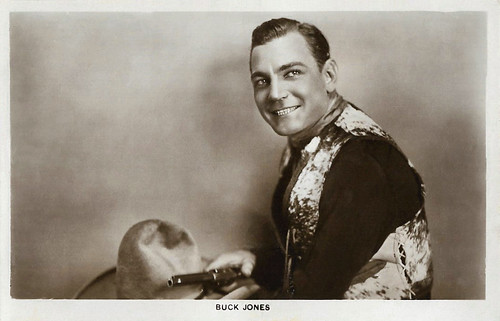
British postcard in the Picturegoer Series, London, no. 146a. Photo: Albert Witzel, Hollywood.
American film star Buck Jones (1891–1942) starred in many popular B-Westerns of the 1920s, 1930s, and 1940s. Executive William Fox decided to use him as a backup to Tom Mix. This led to his first starring role, The Last Straw (Denison Clift, Charles Swickard, 1920). With his famed horse Silver, Jones would make more than 160 films.
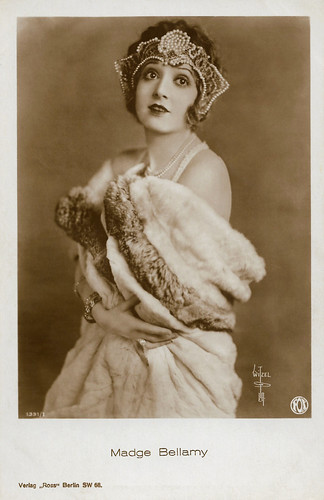
German postcard by Ross Verlag, no. 1331/1, 1927-1928. Photo: Witzel / Fox.
Madge Bellamy (1899-1990) was a beautiful and temperamental leading lady of the silent era, known for such classics as John Ford's first Western The Iron Horse (1924). She appeared in about fifty silent films and also in a dozen sound films, including the cult favourite White Zombie (1932). By the late 1930s, her film career had virtually ended, but in 1943 she became again fodder for the press when she was arrested for shooting her former lover.

German postcard by Ross Verlag, Berlin no. 1341/1, 1927-1928. Photo: Witzel / Fox.
Alma Rubens (1897–1931) was an American film actress and stage performer. She first acted at Triangle and Cosmopolitan, where she starred in the hit Humoresque (1920), based on a Fanny Hurst story and scripted by Frances Marion. The film won a precursor of the Oscars. While at Fox, Rubens peaked in the hit melodrama East Lynne (1925) opposite Edmund Lowe and Lou Tellegen. Yet, her drug abuse ended her career. She died young of a combination of pneumonia and bronchitis.
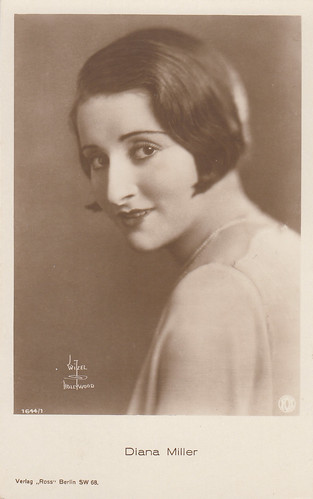
German postcard by Ross Verlag, no. 1644/1, 1927-1928. Photo: Witzel, Hollywood / Fox. Collection: Marlene Pilaete.
American actress Diana Miller (1902-1927) acted in silent motion pictures for Famous Players-Lasky and Fox. She had red hair and excelled in playing roles which required delineation of character. She was briefly married to actor William Boyd and director and producer George Melford. She suffered a breakdown about a year before her death and was treated at a sanatorium.
The first film star portrait to appear in the Los Angeles Times
Albert Walter Witzel was born in 1879 in Deadwood, South Dakota. He was the son of German immigrants August Witzel and Catherine Siefert. The family moved to Seattle in 1886 and Albert signed up as a photographer’s apprentice in 1894. Learning quickly, the young man eventually ran the studio. He moved to Los Angeles as early as 1898 and began working as a clerk in the photographic studio of Coules & Dando. In 1905, Witzel bought his employer’s studio and leased the one above it. He began by photographing society persons and their children. His brother Charles helped manage the business.
Witzel quickly established a clientele that included theatre actors. The astute businessman quickly recognised the value of celebrities to help promote his business and began reaching out to theatrical entertainers in need of carefully crafted portraits to lure customers. As David Shields points out in his book, 'Still: American Silent Motion Picture Photography,' Witzel "favored pronounced facial expressions for women. Furthermore, he had a penchant for typifying sitters into the character types of the old stock companies"'
It was only a short step from the stage to the cinema, especially if you lived in California. Hollywood was becoming the movie capital when independent film companies began moving to Los Angeles to escape the regulations from the Motion Picture Trust and the harsh weather of New York. These companies had recently introduced the practice of promoting the stars of their films, helping to create brand awareness among consumers, who flocked to movies starring their favourites. This star system became the basis for selling films to distributors and the public.
The Balboa Film Co. hired him in 1913-1914 to shoot portraits of their star stable, quickly followed by companies like Triangle-Ince. Witzel's photograph of Viola Barry from Balboa's The Sea Wolf (Hobart Bosworth, 1913) was the first film star portrait to appear in the Los Angeles Times on 21 August 1913. This was followed by a portrait of Elsie Albert as the princess in the Powers Picture Co.’s Venus Feature film, Aladdin and his Wonderful Lamp (Harry C. Mathews, 1913), in the Los Angeles Times of 27 August 1913. A Witzel portrait of actress Lois Weber from the Phillips Smalley Co. ran in September. Beginning in 1915, Witzel's work ran regularly in the Los Angeles Times.
After he made a name for himself, Witzel had a Craftsman residence built in 1914. It was designed and constructed by William Fleming in the Craftsman style with Japanese influences. The now renowned Albert W. Witzel Residence is located at 226 S. St. Andrews Place between Second and Third Streets in the Wilshire Community Plan Area. Witzel remained there until his death.
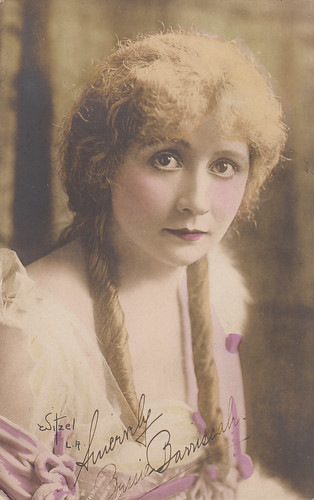
American postcard. Photo: Witzel, Los Angeles. Collection: Marlene Pilaete.
American actress Bessie Barriscale (1884-1965) was a silent film star in the 1910s. Hollywood marketed her as the "girl with the biggest eyes". Barriscale became one of the highest-paid actresses of the time.
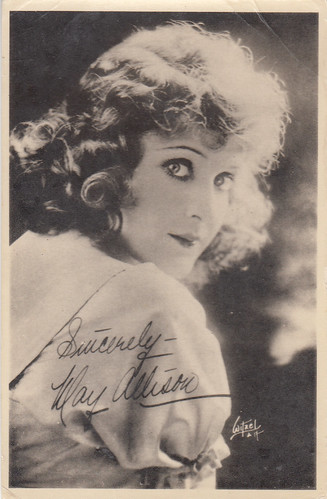
American AZO postcard. Photo: Witzel, Los Angeles. Collection: Marlene Pilaete.
May Allison (1890-1989) was an American actress whose greatest success was achieved in the early part of the 20th century in silent films, although she also appeared on stage.

American AZO postcard. Photo: Witzel, Los Angeles. Collection: Marlene Pilaete.
American actress Lucille Carlisle (1895-1958) made silent films for Vitagraph Studios. With comedian and director Larry Semon, she made 25 films. After their professional and personal relationship ended, she also left film work.

American AZO postcard, no. 192. Photo: Witzel, Los Angeles. Collection: Marlene Pilaete.
Francelia Billington (1895-1934) was an early American silent-screen actress and an accomplished camera operator.
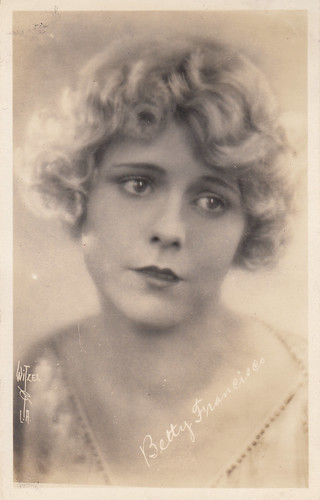
American AZO postcard. Photo: Witzel, Los Angeles. Collection: Marlene Pilaete.
Betty Francisco (19301950) was an American silent-film actress, appearing primarily in supporting roles. Her sisters Evelyn and Margaret were also actresses.
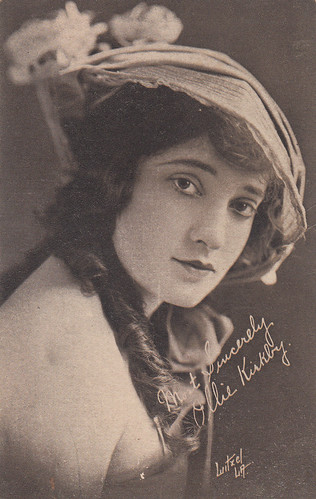
American postcard by American Publishing Co., Los Angeles, Cal., U.S.A.. Photo: Witzel, Los Angeles. Collection: Marlene Pilaete.
American actress Ollie Kirkby (1886-1964) was a brunette silent film, stage and vaudeville actress. For Kalem Kalem, she was the star of one- and two-reelers such as The Social Pirates (1916).

American postcard by Film Stars Portrait Co., Los Angeles, no. 657. Photo: Witzel, Los Angeles. Collection: Marlene Pilaete.
American actress Gloria Joy (1910-1970) began her career in the film industry at age seven when her stepfather, Sherwood MacDonald, formed Mission Productions in the autumn of 1918 to produce a series of films showcasing Joy as a child actress. She starred in such films as The Midnight Burglar (1918) and The Locked Heart (1918). As a young adult, she continued her career with such silent films as Phantom Police (1926).
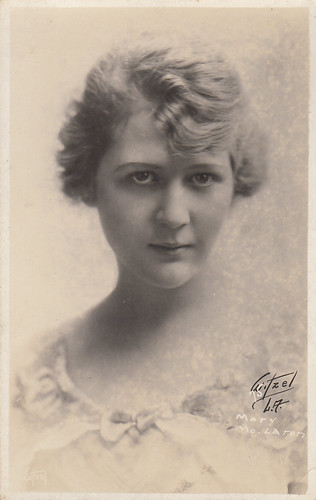
American AZO postcard, no. 75. Photo: Witzel, Los Angeles. Collection: Marlene Pilaete.
Blonde and blue-eyed Mary MacLaren (1896–1985) was an American silent film actress. She was the younger sister of actress and film producer Katherine MacDonald. Discovered by director Lois Weber and her husband, producer Phillips Smalley, Mary was launched in the lead of Shoes (Lois Weber, 1916). Among her other Universal films were three directed by Tod Browning, including Bonnie, Bonnie Lassie (1919). After about twenty films, MacLaren left Universal in 1921 and successfully performed in ten more films, including The Wild Goose (1921).
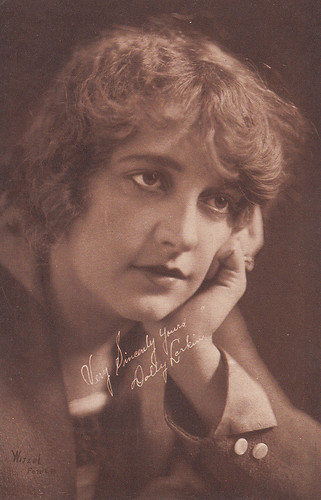
American postcard by Maurer, Schultz & Co Publishers, Los Angeles, Cal., U.S.A. Photo: Witzel, Los Angeles. Collection: Marlene Pilaete.
American actress Dolly Larkin (1889-1976) was known for such silent films as Black Beauty (1913), The Broken Barrier (1914), and The Labyrinth (1915). She was married to George Larkin.
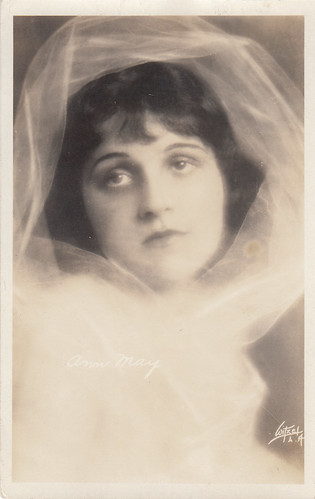
American AZO postcard, no 10. Photo: Witzel, Los Angeles. Collection: Marlene Pilaete.
American silent film actress Ann May (1898-1985) appeared in motion pictures from 1919 to 1925. She had her breakthrough as the leading lady opposite Charles Ray in Paris Green (1920). As an actress, she was diverse enough to play a daring rider or a delicate society girl from the East. In 1925, she married the screenwriter and producer C. Gardner Sullivan.

American postcard, no. 212. Photo: Witzel, Los Angeles. Collection: Marlene Pilaete.
American actress Myrtle Stedman (1883-1938) started her film career in 1910 at the Selig studio in Western and action short films. She was the only female member of Selig at that time, making her the female lead in all of that studio's Westerns. After Selig, Stedman joined the Hobart Bosworth Productions Company and she also worked for Metro-Goldwyn-Mayer and Famous Players–Lasky studios. She retired in 1931.
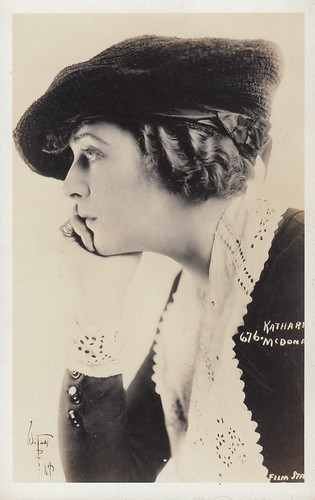
American AZO postcard, no. 676. Photo: Witzel, Hollywood. Collection: Marlene Pilaete.
Katherine MacDonald (1891-1956) was an American stage and film actress, film producer, and model. She was the older sister of actresses Miriam MacDonald and Mary MacLaren. Katherine started her career as a popular model in New York City in the 1910s. MacDonald moved to Los Angeles in 1917 and her first significant role was in Shark Monroe (1918) opposite William S. Hart. She also became one of the first women to produce films in Hollywood and from 1919 to 1921, she produced nine features for her company, Katherine MacDonald Pictures. MacDonald earned about $50,000 per picture from a contract with First National. From 1922 to 1925 she appeared in films produced by B. P. Schulberg. Her films typically were romantic dramas. MacDonald made only two pictures after 1923, one each in 1925 and 1926.

British postcard by Trans-Atlantic Film Company, 1914. Photo: Witzel, Hollywood. Collection: Marlene Pilaete.
Louise Fazenda (1895-1962) was a gawky, highly popular funny girl in slapstick comedies for Keystone Studios. She paired up well with comedian Charlie Murray. Her best-known character was her country bumpkin - complete with spit curls, multiple pigtails, and calico dresses. In the early 1920s, Louise left Sennett's company and progressed to feature films, where her eccentric talents were greatly utilised in musicals and knockabout comedies.
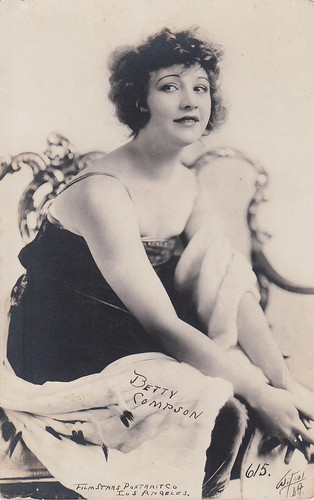
American postcard by Film Stars Portrait Co., Los Angeles, no. 6/5. Photo: Witzel, Hollywood. Collection: Marlene Pilaete.
Blond, blue-eyed Betty Compson (1897–1974) was an American actress and film producer. She peaked in silent cinema and early talkies and is best known for her performances as a suicidal prostitute rescued by a stoker (George Bancroft) in The Docks of New York (Joseph Von Sternberg, 1928), and as the manipulative carnival girl Carrie in the part-talkie The Barker (George Fitzmaurice, 1928), the latter earning a nomination for the Academy Award for Best Actress.
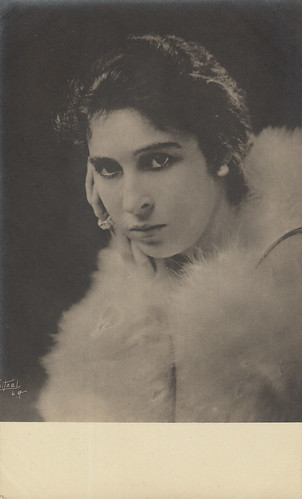
Vintage postcard. Photo: Witzel, Los Angeles. Collection: Marlene Pilaete.
American actress Edith Storey (1892-1967) was a silent film star who was an unusual combination of an intelligent actress and an outdoor athlete. She often appeared in Westerns, period dramas and adventure films. For a long time, she worked for Vitagraph and in 1918, she became one of the stars of Metro.
Rembrandt lighting and moody shadows
Distinguished by Rembrandt lighting and moody shadows, and by dramatic poses and settings, Albert Witzel’s photos set the tone for Hollywood studio photography. Witzel expanded his work with studios, occasionally shooting freelance images of Sennett bathing beauties in 1916 that were published in magazines and newspapers, and working on an assignment for Fox Studios in 1917, photographing Theda Bara in a series of somewhat soft pictorialist images for some of her best-known films, Cleopatra (J. Gordon Edwards, 1917), Madame du Barry (J. Gordon Edwards, 1917) and Salome (J. Gordon Edwards, 1918).
Film star photographs quickly became a regular part of film coverage by newspapers and magazines. Witzel made portraits of such silent film stars as Lilian Gish, Bessie Love, Theda Bara, Clara Bow, Bebe Daniels, and Charlie Chaplin. For the record, it was during a posing session in a Witzel studio that Harold Lloyd lost two of his fingers in 1919. Somehow, it was decided that Lloyd would pose with prop bombs, and pretend to light some. Unbeknownst to everyone, a real bomb created for action shoots had been thrown in the prop bomb box at the studio after a special practice that week. Through the late 1910s and 1920s Witzel's portraits featured frequently in fan magazines like The Moving Picture World, Photoplay and Motion Picture, becoming an important promotional and publicity tool.
His business flourished and Witzel opened a second studio downtown and a third at Hollywood Boulevard and Vine Street. To maintain the high quality and output required for his film work, Witzel hired Henry Nealson Smith as his laboratory manager to supervise the retouching, developing, and finishing of photographic prints. Charlie Chaplin helped finance a popular restaurant called Henry’s across the street from Witzel’s Hollywood studio and the two became acquainted. Witzel went on to have many photo shoots with the star. Photographers he hired to help him were Walter Frederick Seely and later Max Munn Autrey. Autrey eventually became head of Witzel’s Hollywood Studio at 6324 Hollywood Blvd. from 1922 to 1924. Their work became more intense and exotic, emphasizing a glamorous star look.
From the mid-1920s onwards, film companies began to set up their own photographic studios, rather than continuing to use freelance photographers. Max Munn Autrey departed to found Fox’s portrait department. Witzel did not disappear from the scene, however, and, having established his reputation, continued to practise his craft. Witzel focused more on special shoots for newspapers and magazines, like the Peggy Hamilton fashion features for the Los Angeles Times, and other select sections. His portrait photos were used for many postcards. He signed his portraits by Witzel in holograph white pencil.
After a long illness, Albert Witzel died in 1929 of tuberculosis at age 49 in Banning, California. His brother Charles shut down all the studios except the 7th Street location, which he continued to run. Turning his back on Hollywood glamour, Charles Witzel focused the business on portraiture for high school graduations, special gatherings, businesses and upper-middle-class families. The studio eventually moved to 716 S. Bonne Brae St. and remained in operation through 1952. Albert Witzel is interred at Inglewood Park Cemetery.

French postcard in the Les Vedettes du Cinéma series by Editions Filma, no. 43. Photo: Witzel / Films Pathé.
Marie Osborne Yeats aka Baby Marie Osborne (1911-2010) was the first major child star of American silent films.
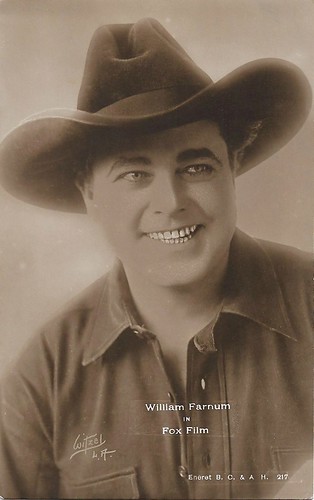
Danish postcard by Eneret B.C. & A.H., no. 217. Photo: Witzel, Los Angeles / Fox Film.
American actor William Farnum (1876-1953) was one of the first major film stars. From 1914 to 1925, Farnum was one of the biggest sensations in Hollywood, earning $10,000 a week. Farnum's silent pictures include the Westerns The Spoilers (1914) - which culminates in a spectacular saloon fistfight, Drag Harlan (1920), and the drama-adventure If I Were King (1921).

American Arcade card. Photo: Witzel, L.A. Conway Tearle in Marooned Hearts (George Archainbaud, 1920).
Conway Tearle (1878-1938) was an American stage actor who became famous as Ben Hur in several stage productions. He went on to perform in silent and early sound films. His first film was The Nightingale (1914) and his last was a film adaptation of Shakespeare's Romeo and Juliet (1936). He was often cast as the dashing hero or ardent lover. Tearle appeared in some 93 films over his career and at the end of the 1910s and early 1920s, he was at times one of the highest-paid leading men in Hollywood.
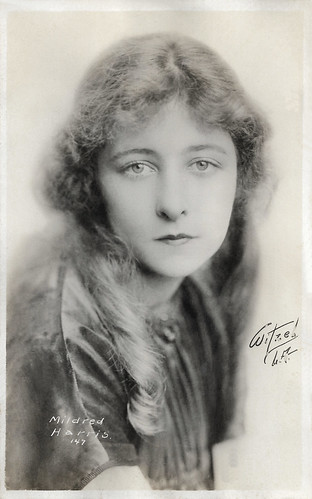
American postcard, no. 147. Photo: Witzel, L.A.
American film actress Mildred Harris (1901-1944) began her career in the film industry as a child actress when she was 11 years old. She was also the first wife of Charlie Chaplin.

American arcade postcard. Photo: Witzel, L.A.
Shannon Day (1896-1977) was an American silent film actress with blue eyes and reddish brown hair who appeared in supporting parts in numerous productions. Before her film debut, she was a Ziegfeld Girl.
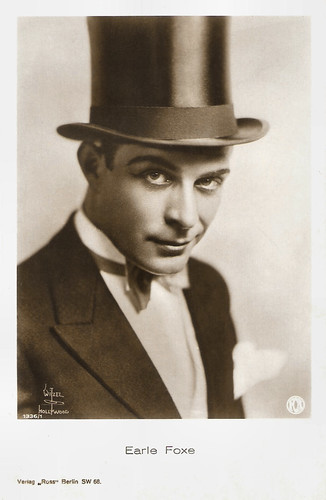
German postcard by Ross Verlag, no. 1336/1, 1927-1928. Photo: Witzel, Hollywood / Fox.
American actor Earle Foxe (1891-1973) starred in 148 films between 1912 and 1946. He went to New York as a young man and became a successful stage star. In 1922, he moved to Hollywood and was one of the attractive and wicked screen gigolos of the 1920s.

German postcard by Ross Verlag, Berlin, no. 1652/1, 1927-1928. Photo: Witzel, Hollywood / Fox.
J. Farrell MacDonald (1875-1952) was an American film and theatre actor and silent film director. Between 1911 and 1951, the character actor appeared in some 325 films, including 25 productions directed by John Ford. MacDonald also directed over 50 silent films between 1912 and 1917.
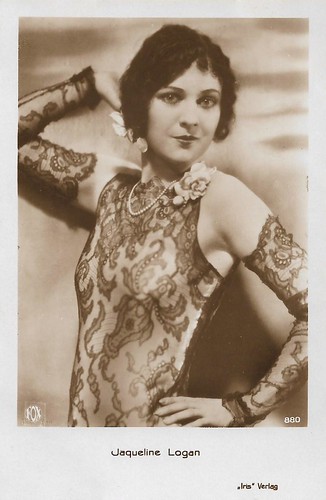
Austrian postcard by Iris Verlag, no. 880. Photo: Albert Witzel / Fox.
Jacqueline Logan (1901-1983) was an American actress of the silent screen. Her most famous part is that of Mary Magdalene in The King of Kings (1927) by Cecil B. DeMille.
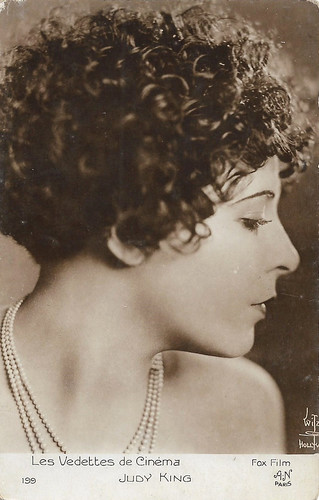
French postcard in the Les vedettes de cinéma series by A.N., Paris., no. 199. Photo: Witzel, Hollywood / Fox Film.
Judy King (1901-1987) was an American actress in the silent film, known for She Wolves (1925), The Gay Retreat (1927) and John Ford's Upstream (1927). She was married to director Tim Whelan.

French postcard in the Les vedettes de Cinéma series by A.N., Paris, no. 204. Photo: Witzel / Fox Film.
Margaret Livingston (1895–1984) was an American film actress and businesswoman, most notable for her work during the silent film era. She remains best known today as 'the Woman from the City' in F.W. Murnau's masterpiece Sunrise: A Song of Two Humans (1927).
Sources: Marlene Pilaete (La Collectionneuse, for L’Encinémathèque, now defunct), David Shields (Still), Mary Mallory (The Daily Mirror), National Portrait Gallery, Wikitree, Biblio, Los Angeles Department of City Planning, Wikipedia (French) and IMDb.
No comments:
Post a Comment